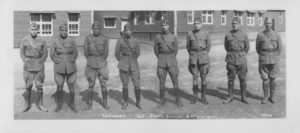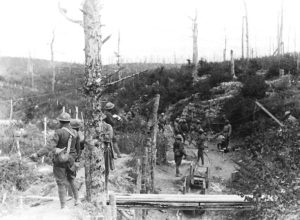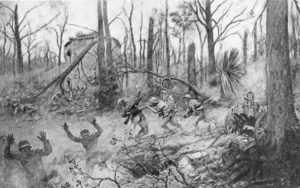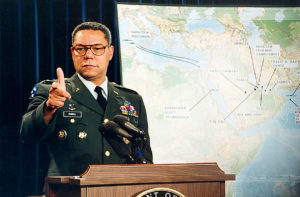 When the U.S. entered World War One in 1917, two “all-colored” combat units were created: the 92nd and the 93rd Infantry Divisions. Within these divisions, for the first time in U.S. military history, black soldiers would be led by black officers. One of these young leaders, Lieutenant William Herbert, the main character of the novel: A Place near the Front, is shown fourth from the left in the above picture. He was a member of the 325th Field Signal Battalion that provided radio and telephone communications to the 20,000 man 92nd Division.
When the U.S. entered World War One in 1917, two “all-colored” combat units were created: the 92nd and the 93rd Infantry Divisions. Within these divisions, for the first time in U.S. military history, black soldiers would be led by black officers. One of these young leaders, Lieutenant William Herbert, the main character of the novel: A Place near the Front, is shown fourth from the left in the above picture. He was a member of the 325th Field Signal Battalion that provided radio and telephone communications to the 20,000 man 92nd Division.
 Wireless radio had only recently been invented when Herbert and the 92nd headed off to war in 1918. The young radio men who were to set up and operate radio and telephone stations in the battle zones of France had been quickly trained in a special army radio course conducted at Howard University. Herbert and many others who took the crash course were already Howard students finishing up their academic programs.
Wireless radio had only recently been invented when Herbert and the 92nd headed off to war in 1918. The young radio men who were to set up and operate radio and telephone stations in the battle zones of France had been quickly trained in a special army radio course conducted at Howard University. Herbert and many others who took the crash course were already Howard students finishing up their academic programs.
Black soldiers had fought and died in all prior U.S. conflicts dating all the way back to the Revolutionary War, but had usually been consigned to the most menial and dangerous jobs: ammunition handling, clearing mine fields, recovering unexploded ordinance from the battlefield, and burying the dead. Most army officials didn’t believe that black soldiers were smart enough to lead troops or learn radio. President Woodrow Wilson, a staunch segregationist who instituted racial segregation in all U.S. federal jobs shortly after his 1913 election, had reluctantly established the two black divisions as a cynical give-away to black leaders who had long complained that if black soldiers were expected to fight and die in battle, they should be able to rise to the officer ranks and develop technical skills. Military leaders grudgingly accepted the president’s action, but tried hard to cause the black officers and technicians to fail.
One of the two colored units, the 93rd Infantry Division, never got to fight a single day with U.S. forces. General Pershing immediately dumped them onto the French army as soon as they arrived in France. But it turned out to be a stroke of luck for the 93rd, as the French loved these dusky fighting men who proved themselves to be great warriors. They emerged at the end of the war as the most highly decorated of all U.S. units.
William Herbert and his fellow soldiers of the 92nd had a tougher time, as they served under U.S. generals who harassed them and complained about them, always trying to sabotage their reputation and put a negative twist on stories from the front lines. These resentful senior officers were ready to sacrifice black troops and even suffer defeat on the battlefield to put “uppity” blacks in their place.
 Despite these obstacles, the troops of the 92nd fought with distinction in all three of the division’s major campaigns during the final year of the bloody, four-year war. In one critical mission, when Lieutenant Herbert and his lightly armed team of radiomen found themselves pinned down by devastating enemy fire and had no infantry soldiers to protect them, they took the offensive themselves, charging and disabling the enemy forces and capturing many prisoners in deadly hand-to-hand combat. Time and again, the Buffalo Soldiers distinguished themselves even though they were often ill-supplied and poorly led by the senior command. As it turned out, the only troops who actually failed in their mission were two senior officers, neither of them black, who cracked under fire and were unable to lead their troops during the critical Argonne offensive. Sadly, their fellow senior officers tried to cover for them, whitewashing their failure by attempting to scapegoat several black officers who were charged with cowardice and dereliction of duty.
Despite these obstacles, the troops of the 92nd fought with distinction in all three of the division’s major campaigns during the final year of the bloody, four-year war. In one critical mission, when Lieutenant Herbert and his lightly armed team of radiomen found themselves pinned down by devastating enemy fire and had no infantry soldiers to protect them, they took the offensive themselves, charging and disabling the enemy forces and capturing many prisoners in deadly hand-to-hand combat. Time and again, the Buffalo Soldiers distinguished themselves even though they were often ill-supplied and poorly led by the senior command. As it turned out, the only troops who actually failed in their mission were two senior officers, neither of them black, who cracked under fire and were unable to lead their troops during the critical Argonne offensive. Sadly, their fellow senior officers tried to cover for them, whitewashing their failure by attempting to scapegoat several black officers who were charged with cowardice and dereliction of duty.
The sudden and unexpected end of the war did not improve things for the Buffalo Soldiers. General Pershing refused to allow black troops to march in the Paris victory parade, even though the French proudly showcased their own black Algerian, Moroccan and Senegalese troops in the celebration. And when they returned home in 1919, they faced a resurgence of racial animosity in the U.S. Lynching of blacks had increased from fifty-eight in the year 1918 to seventy-seven in 1919, the year black soldiers began to return to the States. Many of those lynched were black soldiers in uniform. James Weldon Johnson referred to the return of the American black soldiers as the Bloody Summer of 1919.
Like returning soldiers in all wars, William Herbert and other surviving Buffalo soldiers would pick up the pieces of their lives, as best they could. But most were disappointed that their battles in President Wilson’s “War to make the world safe for democracy” had not improved their lot at home. Herbert was unable to transition his passion for radio into peacetime work, as U.S. industry was not quite ready accept men of color in engineering and technology fields. Undaunted, he enrolled in Howard University and prepared himself for a career in dentistry.
 But the sacrifices of the black warriors was not in vain, as their efforts had opened new opportunities for soldiers of color and forever changed the face and soul of the U.S. military. Thirty years after the end of the war, the army would be completely desegregated, although none of the black heroes of World War One would live to see the day when the U.S. armed forces and the entire nation would be led by men of color.
But the sacrifices of the black warriors was not in vain, as their efforts had opened new opportunities for soldiers of color and forever changed the face and soul of the U.S. military. Thirty years after the end of the war, the army would be completely desegregated, although none of the black heroes of World War One would live to see the day when the U.S. armed forces and the entire nation would be led by men of color.